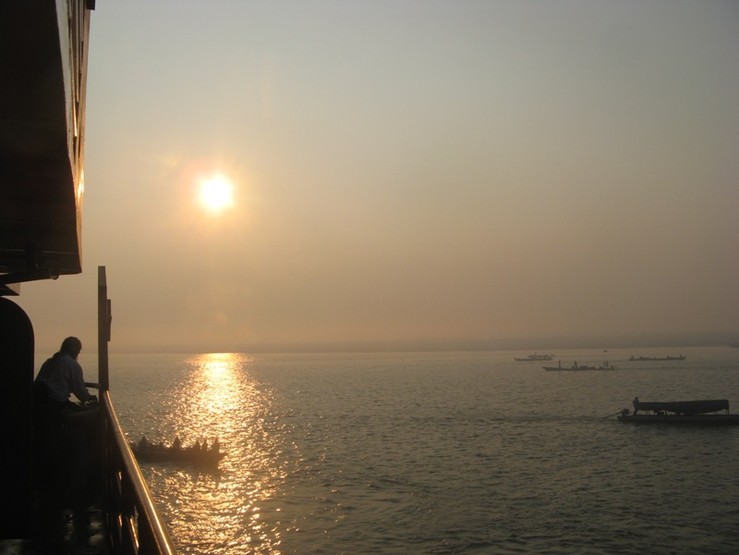Trip on the Amazon River - Life on a Cargo Ship - Liebe zur Erde
Main menu:
- Love to Earth
-
my travels
- My Travels
-
Amazon rainforest
- In the Amazon Basin
- The Amazon and its Tributaries
- Settlements in the Amazon and its Tributaries
- Animals along the Amazon River
- Trip on the Amazon River - Life on a Cargo Ship
- Puerto Maldonado
- The Sandoval Lake near Puerto Maldonado
- At Tambopata River and the Clay Lick of the Macaws
- The Market of Iquitos
- Primary Rain Forest and Indian Myths
- Leticia and Tabatinga
- China
- Germany
- France
-
Trekking in the Himalayas
-
Ladakh, India
- Trekking in Ladakh
- Ladakh: Logistics, Equipment and Introduction
- Tso Kar via Pang to Tso Moriri
- Tso Moriri
- Tso Moriri to Sarchu
- The Phuktal Monastery in Zanskar
- Zanskar River Crossing at Chilling
- Video: River Crossing before Zanskar
- Video: Zara-Chu /Tsarap River Crossing
- Video: Ponies Through the Phuktal Monastery
-
Ladakh, India
-
India
- India
- Busrides in India
- Ajanta and Ellora
- Dharamsala
- Goa
- Gujarat
- Kashmir
- Ladakh
- Maharasthra
- Manali
- Rajastan
- Varanassi
- Croatia
- Switzerland
- South America
- Southeast Asia
-
Eurythmy
- Eurythmy
- Technical Basics
- Specialist Areas of Eurythmy
- Eurythmy in Workplaces
- Research on Eurythmy
- Eurythmy Therapy
- My Offers
-
Eurythmy Therapy
- Eurythmy Therapy
- Everything about Eurythmy Therapy
- Research on Eurythmy Therapy
- Publications
- My Offers
- Mediation
- Profile
- Contact
- Blog
- In the Amazon Basin
- The Amazon and its Tributaries
- Settlements in the Amazon and its Tributaries
- Animals along the Amazon River
- Trip on the Amazon River - Life on a Cargo Ship
- Puerto Maldonado
- The Sandoval Lake near Puerto Maldonado
- At Tambopata River and the Clay Lick of the Macaws
- The Market of Iquitos
- Primary Rain Forest and Indian Myths
- Leticia and Tabatinga
Trip on the Amazon River - Life on a Cargo Ship
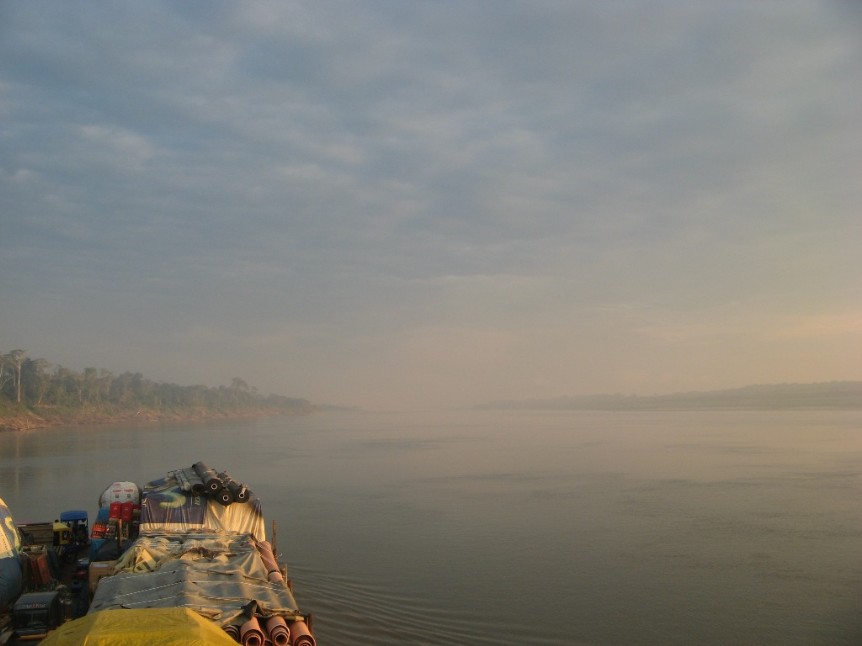
From Pucallpa to Iquitos: a River Journey from the Rio Ucayali to the Amazon to the Baylon II
A fantastic journey -
The Rio Ucayali in Pucallpa
The Rio Ucayali, with Pucallpa at its shores, is the longest tributary to the Amazon. At a junction in front of Iquitos, where it changes quite strongly its character, the river is named the Amazon river.
In Pucallpa are ending all roads into the jungle -
Three days, according to Lonely Planet, should take the travel down river to Iquitos. At the harbor in Pucallpa the captain of the boat speaks about 5 days, presumably because of low water during the dry season. Among the boats lying in the harbor we decide for the Baylon II and can there get a cabin on the middle deck with a beautiful view around the river scenery:
The Baylon II is, same like all the other ships here, a general cargo vessel: it transports goods of all kinds downstream. Beside the cargo it can host several hundred passengers. Their accommodation is on the decks in hammocks which the passengers bring along with them. Beside that there are just a few cabins like ours, if there are at all some on a ship. As a result this means that people hang close together like sardines, waiting to arrive sometimes -
Our landlady at the hotel Sisley claps her hands in horror over her head when she hears about our choice -
The ship and its cargo::
Already in the night we still move to our cabin and from there on we are in a state of constant deep surprise: It is for example incredible what is being carried from people by hand (and litterly by hand or on the head, means by porter) all the steep dirt slope down and disappears in the belly of the ship: Pipe systems, rickshaws, mattresses, bags of cement, tiles, potato sacks, crates, and even a car drives with us. A neighbor ship is fully loaded with crates of toilet paper and beer, while others are loaded with barrels of whatever. After all, it is to supply Iquitos, a city with 400 000 inhabitants to provide for.
Here on the right the cargo ship full of beer crates and rolls of toilet paper:
And below an impression about the local equipment and the dealing with them:
-
The passenger floors:
These are famous means of transport -
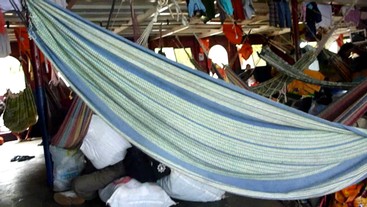
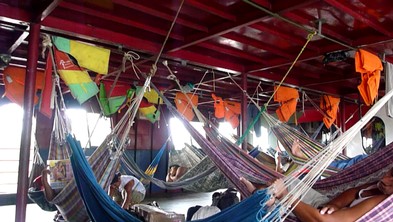
The sonar of the Amazon
Early in the morning after an early departure we see the next surprise: instead of buying an echo sounder for 150 €, the ship employs 5 man to determine the water depth and thus decide for the best route: At the front edge of the vessel are 2 man with marked sticks, which they launched into the water to see where how far the waters arise. Depending of the findings, they shout "right" or "left" up to the captain or the man in green (below) will inform him with hand signs. In addition, 3 more men in a small boat are ahead of the cargo boat and check the grey depths with the same principle. In the first hours of our trip they show every honest effort, showing of their best, but what these troops will keep us, the boat and the passengers busy ... -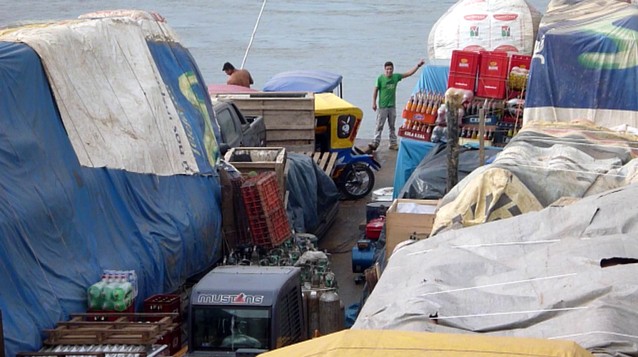
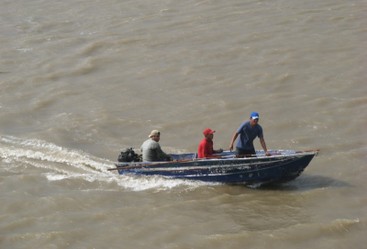
On the right: Our guarding small-
2 days we ride at a relaxed pace, enjoy the view and annoy us about the noise of trampling, knocking, looking and playing children. Tor them is the area of our cabin one ultimate and most popular attraction. We notice the fact that we hardly come forward qua distance, but we don´t think anything of it -
Around lunch and dinner time the queue winds all around the ship and goes even down to the lower deck -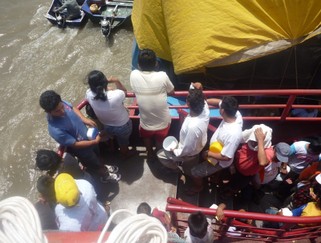
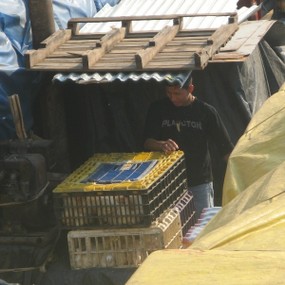
In this box (left) are hiding the chickens which are allowed to get daily killed in front of our eyes, in time to be well cooked and fresh -
The typical pictures while on the boat, which match our activities -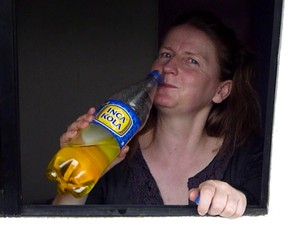 *******
******* 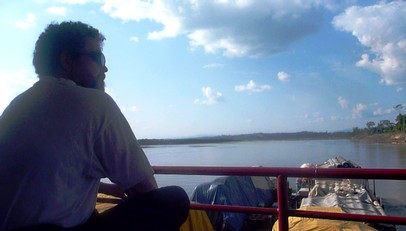
Andreas preferres the table on the railing in front of the cabin, where he spends the day. Mine, despite of the temperatures, is the end corner of the seat directly behind him, just across the cabin wall: I prefer to escape the wind.
An unknown disease, and -
Day 3:
I am crashed with a cold in bed, may be the wind -
Day 4: We run on a sand bank and remain there for another 1.5 days. And I start to fewer up high. So that was more than just wind which caused this...
So my experience of the various rescue attempts by other ships is limited.
However, the average amount of passing vessels is only 1/day. A thrust unit tries for hours to pull us out and relieves us in the end by taking approximately 50-
And here we are once again shocked by the way people work: barefoot, without protective clothing or glove. They work on the steel cables, with which the two vessels are connected -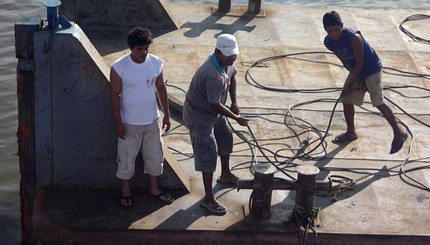
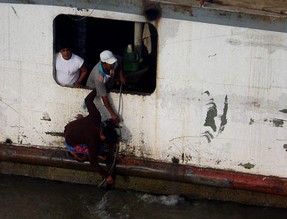
Our solace for the night: A beautiful sunset:
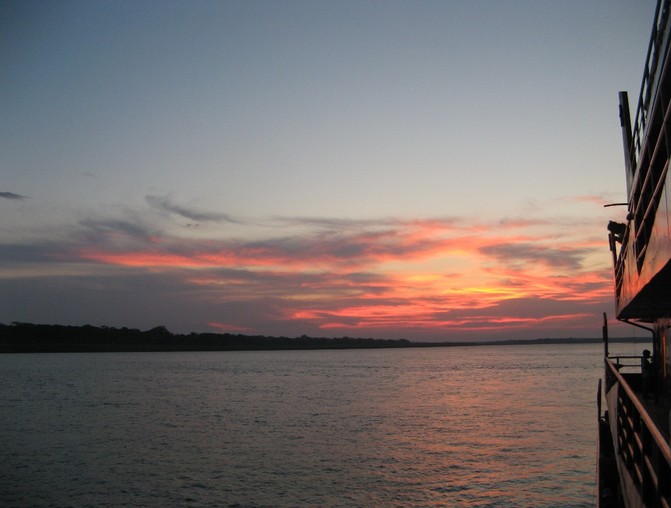
The next day the captain comes on the bright idea to relieve the ship of chargo. His call of the passengers on the day before to leave the ship temporarily, to be brought to shore, was largely ignored. So now the team is forced to the duty to transport several tons of rice sacks to the shore. Mnual work, of course. 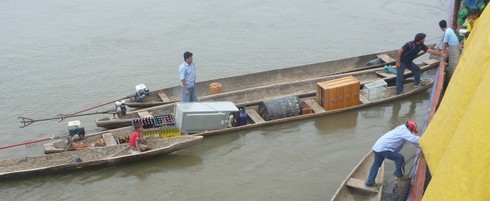 The locals in the jungles around realize that we are stuck on the sandbank. Now en masse canoes swam up, this small dug outs, and run to relieve us from our drinks.
The locals in the jungles around realize that we are stuck on the sandbank. Now en masse canoes swam up, this small dug outs, and run to relieve us from our drinks.
Here is a picture of the dugouts.
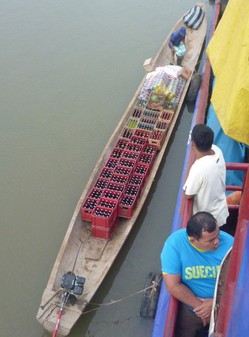
A lumberjack takes a whole barrel of beer crates (works makes you thirsty, work does ...) with but just a few crates of lemonade are there to go.
Coke's on demand, too. Another boat gets, from the depths of our ship, in the middle of this river a large combination refrigerator, which is hoisted onto the dugout, I don´t trust my eyes ...,
We pass an entire warehouse to the locals and are therefore lighter. Later comes a boat from the Henry Group -
In the afternoon finally an other boost unit comes with a recognizable professional team, and pulls us out. 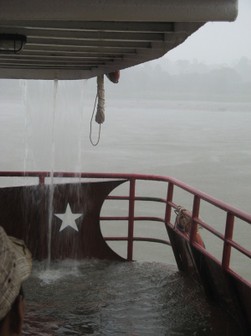
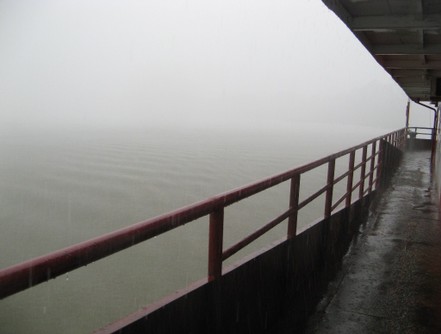
The day ends with a tropical storm, the first since our being here. It is an impressive event!
For the first time beeing here it is quiet in front of our cabin -
Above you see the rushing water, the walk around of the ship is no longer accessible, but if you like, you can swim...
So that was Day 4 and 5.
Day 6, 7 and 8 are quickly told:
Now Andreas gets sick, too. We are well equipped in terms of medical drugs -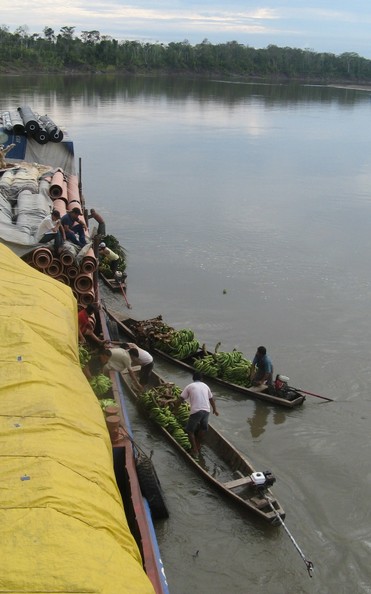
We stop at every banana tree, thus making up for the weight which we have given away in beer creates and passengers. Platanos, cooking-
The perennials are numbered for the record, together with the charge someone from the rural population escorts the thing to sell it on the market in Iquitos.
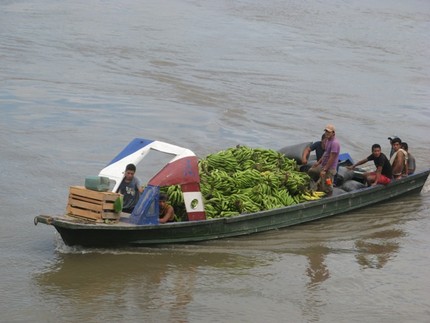
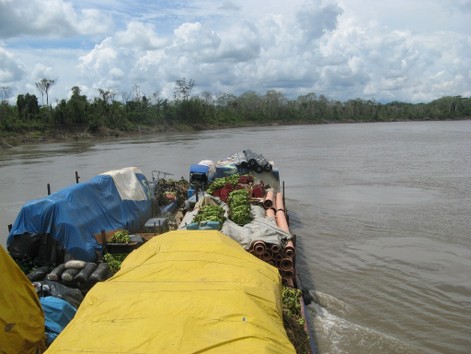
On the left side the Baylon on day 8: compare the condition of the vessel with the beginning of our trip! And note (below): The rickshaws were lifted to make room for the plantains !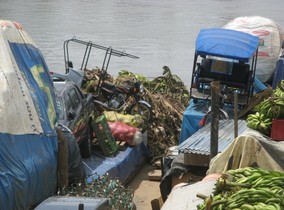
Additionaly empty crates are now reloades by villagers, there is probably somewhere deposit.
And we still have no mobile phone reception.
Meanwhile, we have both diarrheas in a 7 m2 cabin without a separate toilet, where the flushing exppires sometimes for hours, a dattractive affair. From day 6, there is no bread on the ship anymore and the rest of the food is so unpalatable that it´s disgusts to us only to look at it. What we just find out: the kitchen cooks with Amazon water, which is about the quality of the Ganges (mercury, radioactive material by drilling, untreated sewage from all the settlements / cities etc).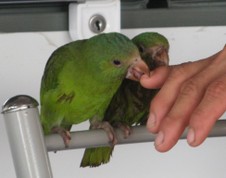
In the "vegetable compartment" of this nice canteen live two parrots and leave their marks. The decapitated giant cock is just hanging upside down in the sink to bleed out and the knife which will cut plantains -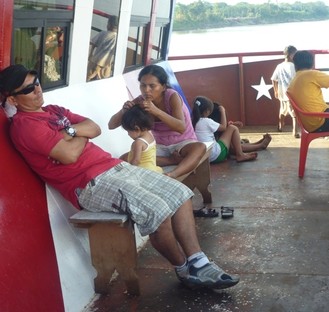
The giant beetles lying around on deck -
The whole families see after each other for lices -
Andreas has a semi-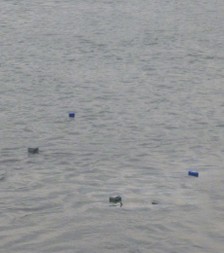
The garbage which we have always neatly disposed of in the bin is thrown out one morning in the river, including all the empty bottles. Poor river, which has to carry every modern civilisation shit. And we had been wondering already why our fellow passengers just threw everything over the side .... But well: we discover this form of cleaning from the inside of our cabin -
Here on the left the team has just discarded oil cans -
Everyday images:
The Amazon offers plenty of variety so far, there is always something new to discover every day -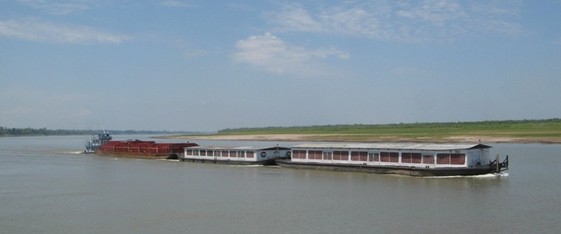
A huge boost unit with beer crates ... -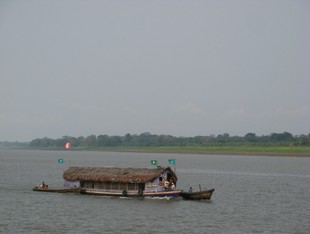
Various water structures, who also serve for the daily living (on the right). There is something like a floating fish farm (below):
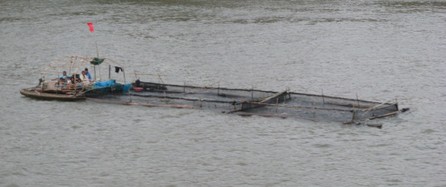
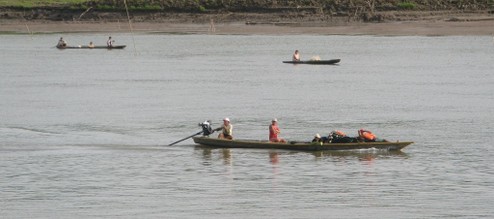
Fishermen (right)
and peoples transport: 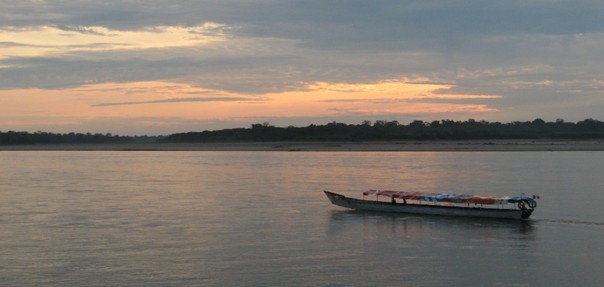
Then the chapter deforestation:
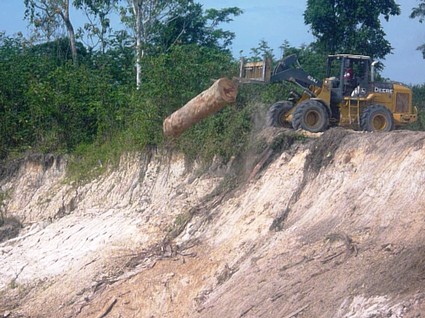
Most modern equipment and machines -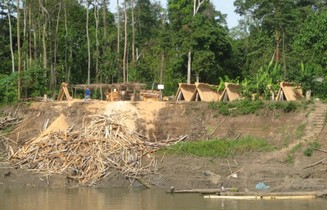
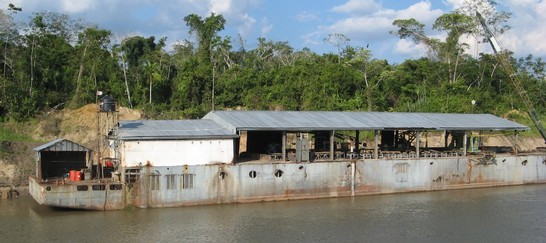
In the middle of nowhere is it a floating sawmill: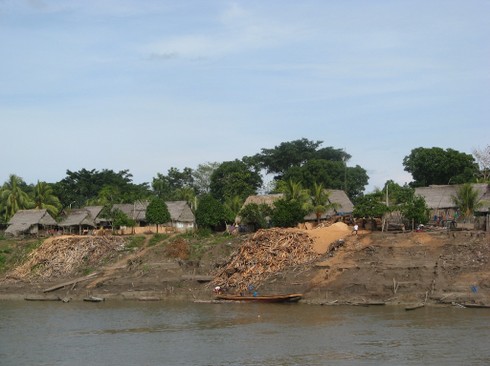
And the one or the other might ask here: what's wrong with the removal of trees, everything is still green in the area ...? -
On the left one of the many villages that craves an existence from logging.
For further transport one usually sees these larger ships:
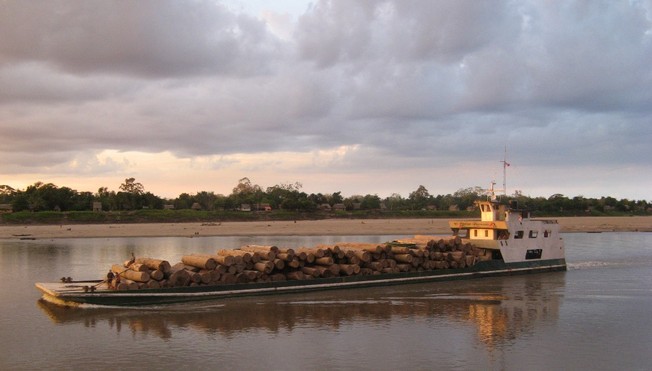
In order to sell the timber, it must be transported over long distances, often for weeks. Who doesnt own a big company, but lives from own manual labor, will chose the way downstream: The people create on the floating timbers a kind of housing structure, the whole thing is controlled through the Peki Pekis, boats with an electric motor with a rotating stick.
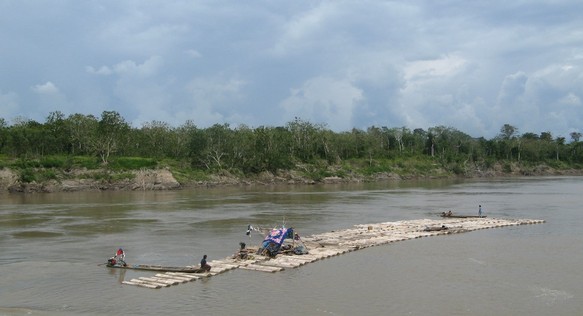
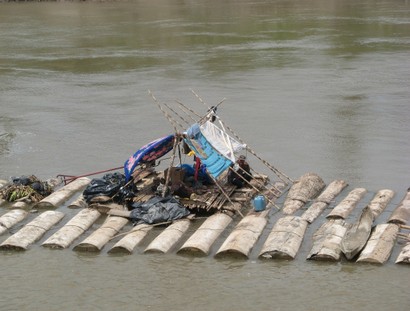
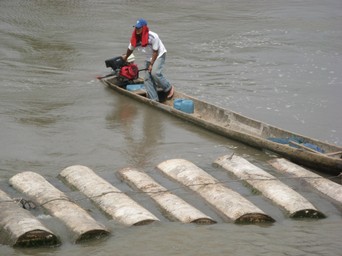
Again and again we are waiting for more cargo:
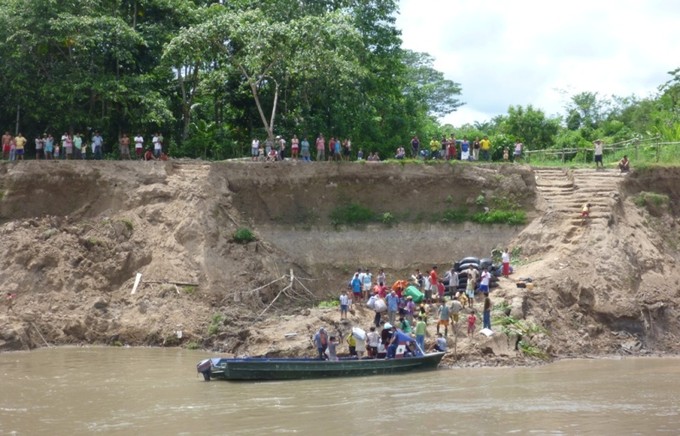
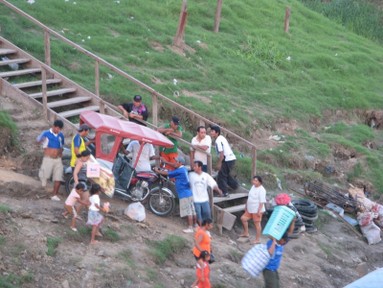
No joke: this rickshaw has to come with us and must be carried over a narrow bridge, made of two floating planks, to become loaded into the hold.
And the rice bags that were booted out, of course, we gather back again: 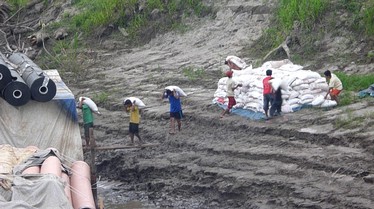
Other ships are stuck on sand banks, including one of the famous Henry. Henry also protects not from running aground. 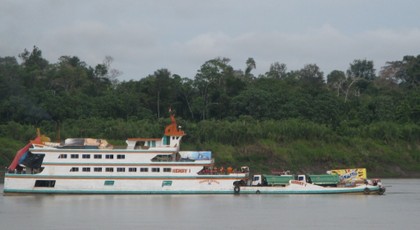
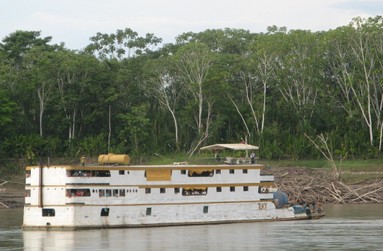
Above the stranded Henry I,
on the right with the same destiny, Tuki
But again we can see also: itno other boat overtakes us -
Sand storms in the Amazonas?
Anyone familiar with the books of the adventurers, has noticed this phenomenon with surprise -
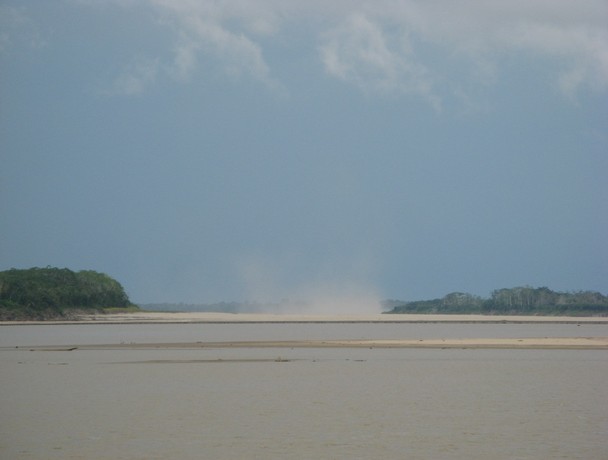
Day 9 + 10:
In the early morning of Day 9 we run again run, this time with courtesy the heavens: with a village right in front of us. Locals are fast and board not before long: they are floating us with all sorts of edible things like hot cakes. On this morning I am eating everything in nearly every amount -
Our stomachs are both fundamentally offended, as we are not so pleased to find out still even days later. But ok. We sit firmly once again and our time runs short noew -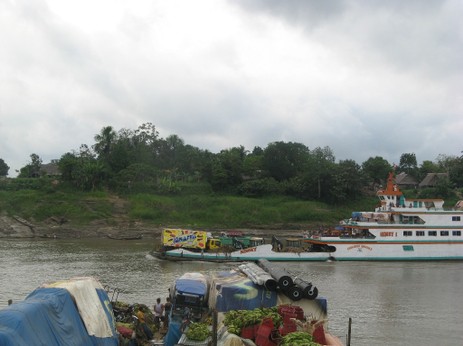
So, we are running out of time and I start running mad with the situation. A Henry overtakes us -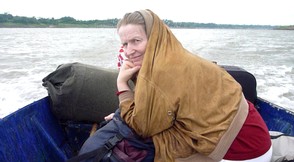
Obviously I am loud and energetic enough, finally we are put into the dinghy and trace the Henry, which is already far ahead. Otherwise, we would probably still be sitting on the Baylon II.
That this boat which the team uses to determine the depth of water, leaks on all sides, yes, we also found out on the way ...
The Henry, on the other hand, is loaded with trucks (frozen foods), excavators, rickshaws and ...: cows. Many of these animals stuck on the lower deck and shit around of themself. But the team make a quieter and more solid performance. The captain will give us a hand for greeting and the passengers seem to originate from a much more educated level: the children are quiet, many people read or play board games. So we get finally the cahance to hang out our hammocks between the locals: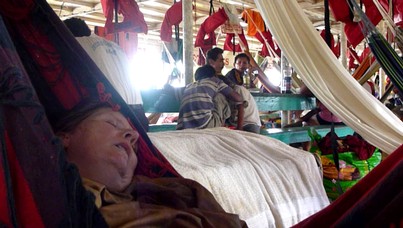
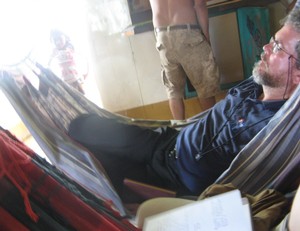
The view once to the left, once to the right. We are done both ....
The Henry needed a total of 8 days for the trip, despite being stuck, too -
So we end up on a dirty clay slope in an deserted industrial area with all our luggage in hand at 3:30 in the morning. Instead of being attacked, we will find the harbor master, who has called us some rickshaws. With infinite relief we check into a middle class hotel -
I hope for the captain and his comrades, that a scheme is adopted which makes it possible to confiscate charge to compensate for missed flights for tourists. Then this fun to make money will stop quickly. The Lonely Planet, I wish a larger budget for actual traveling to make better research. Some weeks later we hear that this year was the lowest water level in a century and the prices in Iquitos did skyrock, because the supplies didn´t came through any more by boat.
Quite a lot was we couldn´t tell! More about our trip under the chapters:
Animals along the Amazon
Human settlements and population ...
as soon as they are finished!
